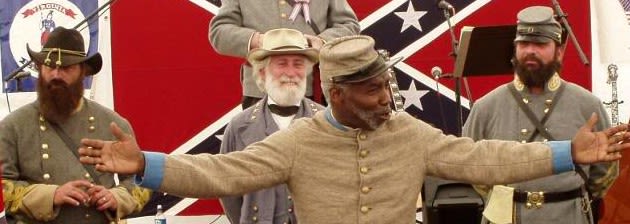A community divided: is it a symbol of remembrance or a symbol of hate?
The debate over the Graham Confederate monument outside the Alamance County Courthouse
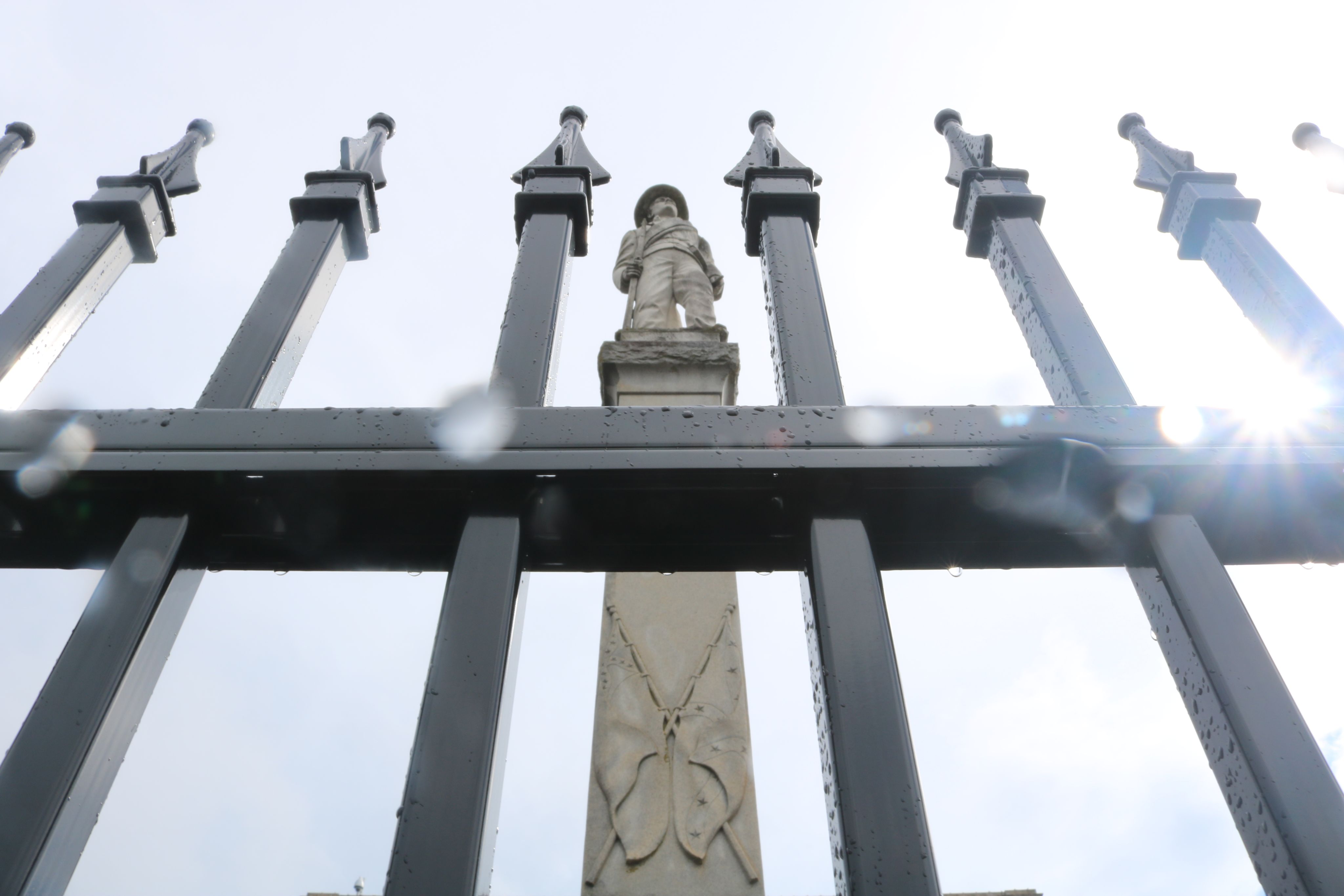
GRAHAM, NC -- A blue Ford F-150 parks in Graham’s Historic District. Stickers on the trunk promote the driver’s political agenda. One sticker shows former President Donald Trump yelling, “Get the Fuck Out of My House!” at former President and First Lady Barack and Michelle Obama as they eat a bucket of KFC. Another sticker, a parody of President Joe Biden’s campaign logo, said, “The Hell with Joe & The Hoe”, referring to Vice President Kamala Harris. A third sticker is a picture of the Graham Confederate monument outside the Alamance County Courthouse with the caption “I Ain’t Coming Down!”
Just minutes away from the truck and the monument, a black billboard towers over Interstate-85/40. Put up by the Southern Poverty Law Center, its message with a heart: REMOVE Alamance County’s Confederate Monument. #TakeItDown #WhoseHeritage.
The duality of these two signs shows the division in Alamance County over the controversy of the Confederate monument in downtown Graham. This division in a city of just over 15,600 people, according to the U.S. Census Bureau in 2019, has led to protests, town meetings, and wide-ranging community action.
According to a report the SPLC, North Carolina has 209 public Confederate symbols and monuments, the fifth most for any state. There are currently more than 2,100 public Confederate symbols throughout the United States, 704 of which are monuments. At least 312 Confederate symbols were removed across the country in between the Charleston church shooting in June 2015 and George Floyd’s death in May 2020. Since then, 167 Confederate symbols were removed. This shows that there were upticks in the removal of Confederate symbols following nationally known incidents of racial violence and periods of social reckoning with issues of race.
The Confederate monument outside the Alamance County Courthouse in Graham was dedicated on May 16, 1914. Standing at approximately 30 feet tall, the monument towers over the city for all to see. It was built by McNeel Marble Co., Supplier, a company responsible for building at least 140 Confederate monuments across the country. Atop the granite base and column stands a generic Confederate soldier made from marble, marching North, stepping forward with his left foot and holding his gun by his side.
There is also a copper box inside the base of the monument with the names of the 1,100 Confederate soldiers in the Civil War from Alamance County, the names of contributors to the monument’s fund, Confederate relics including Confederate money, and the names of the members of the Graham Chapter of the Daughters of the Confederacy.
All four sides of the monument have a different inscription. Tap on each of the images below to read the engravings.
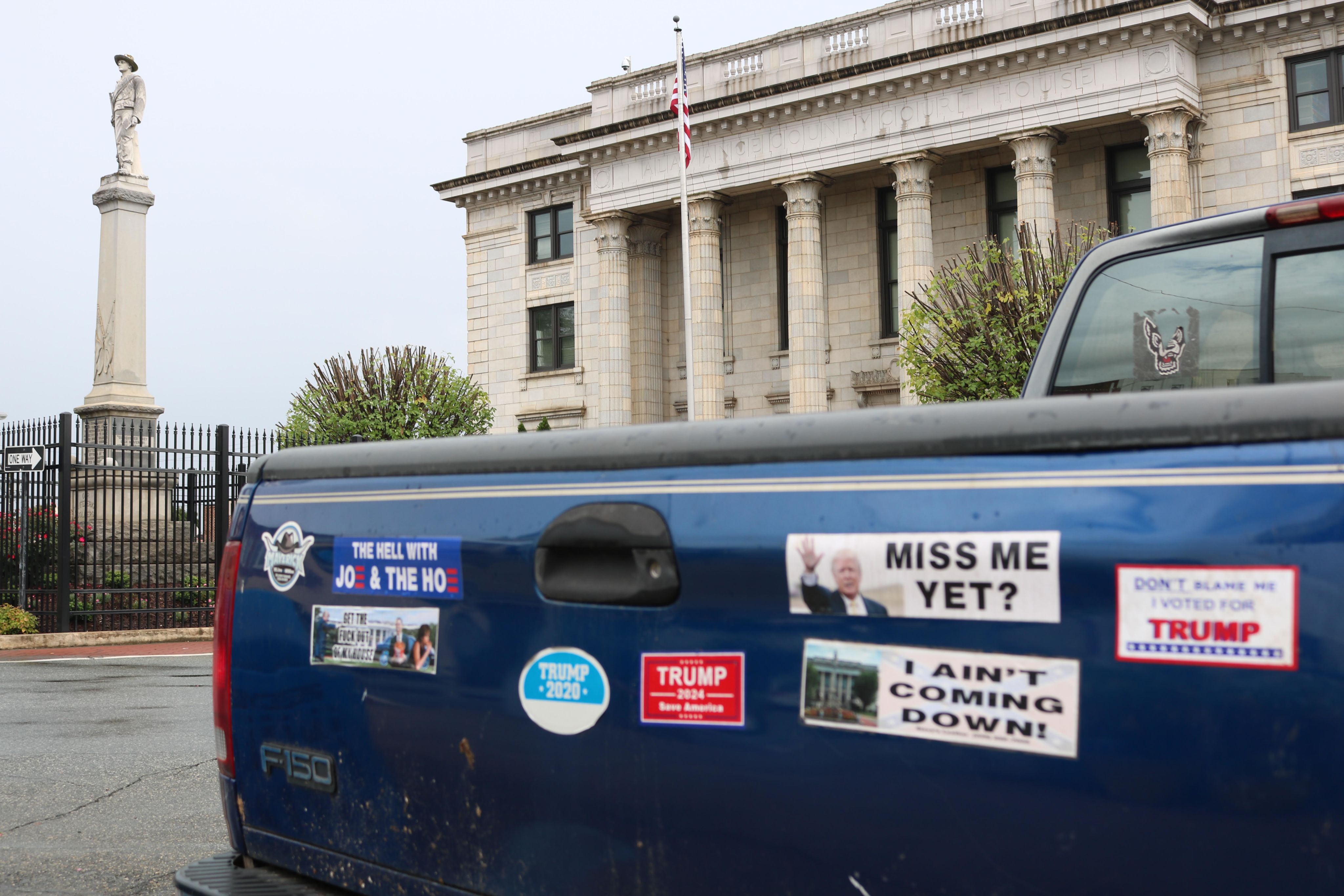
Blue Ford F-150 parks in Graham with a sticker supporting the Confederate monument
Blue Ford F-150 parks in Graham with a sticker supporting the Confederate monument

The SPLC’s billboard in Graham put up in May 2021. Source: SPLC
The SPLC’s billboard in Graham put up in May 2021. Source: SPLC
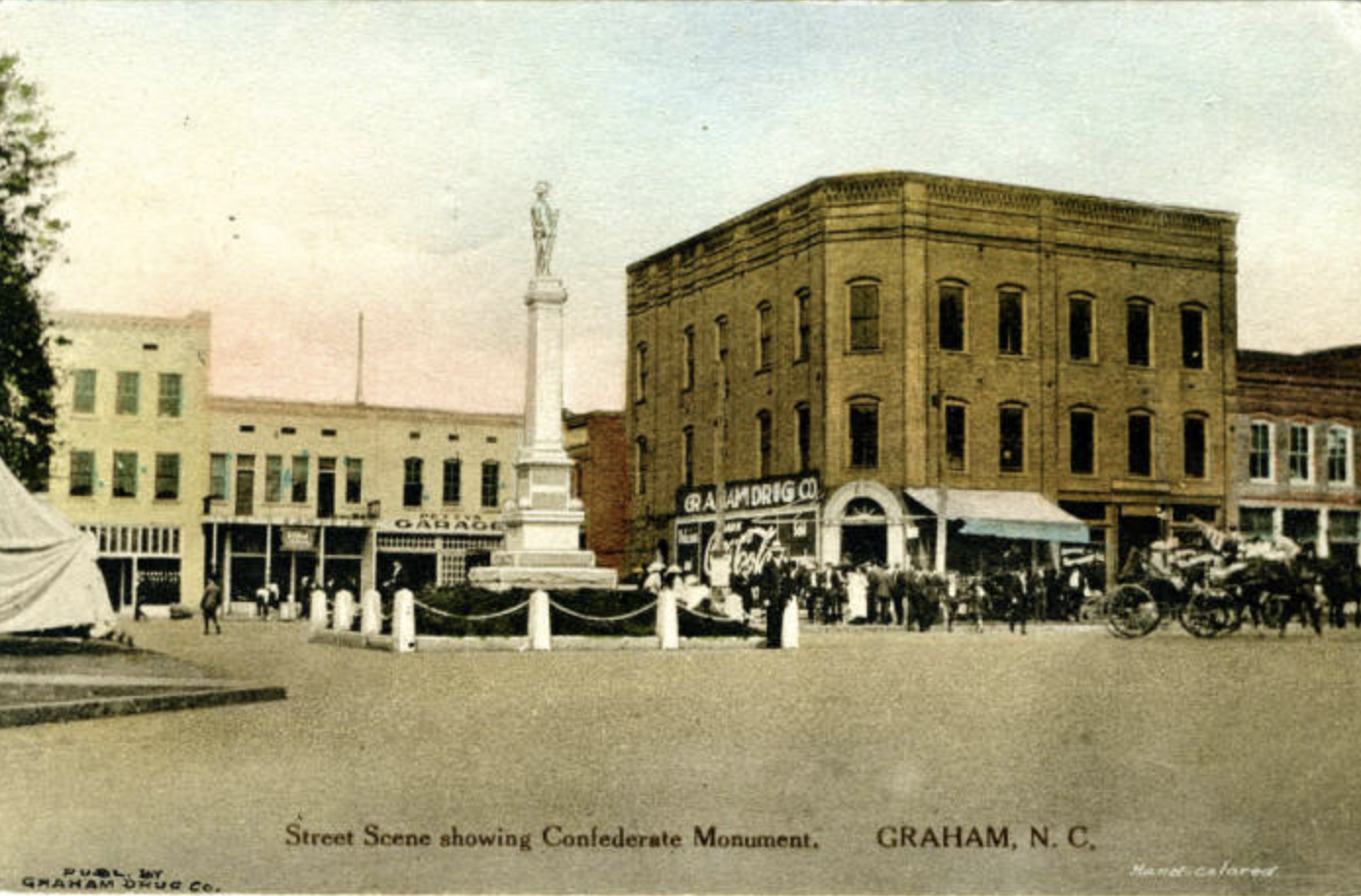
1917 postcard of a street scene showing the Confederate monument in Graham
1917 postcard of a street scene showing the Confederate monument in Graham
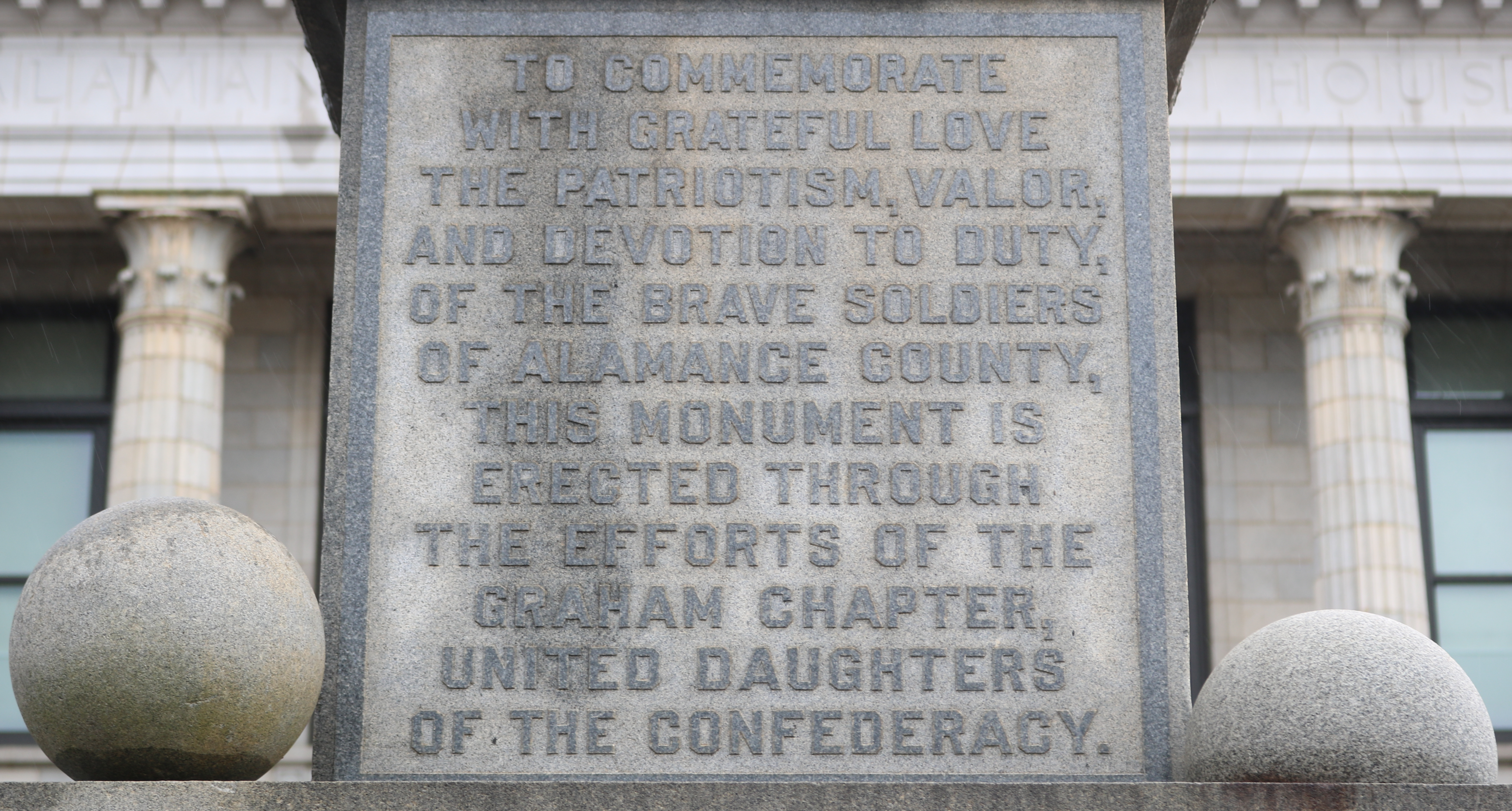
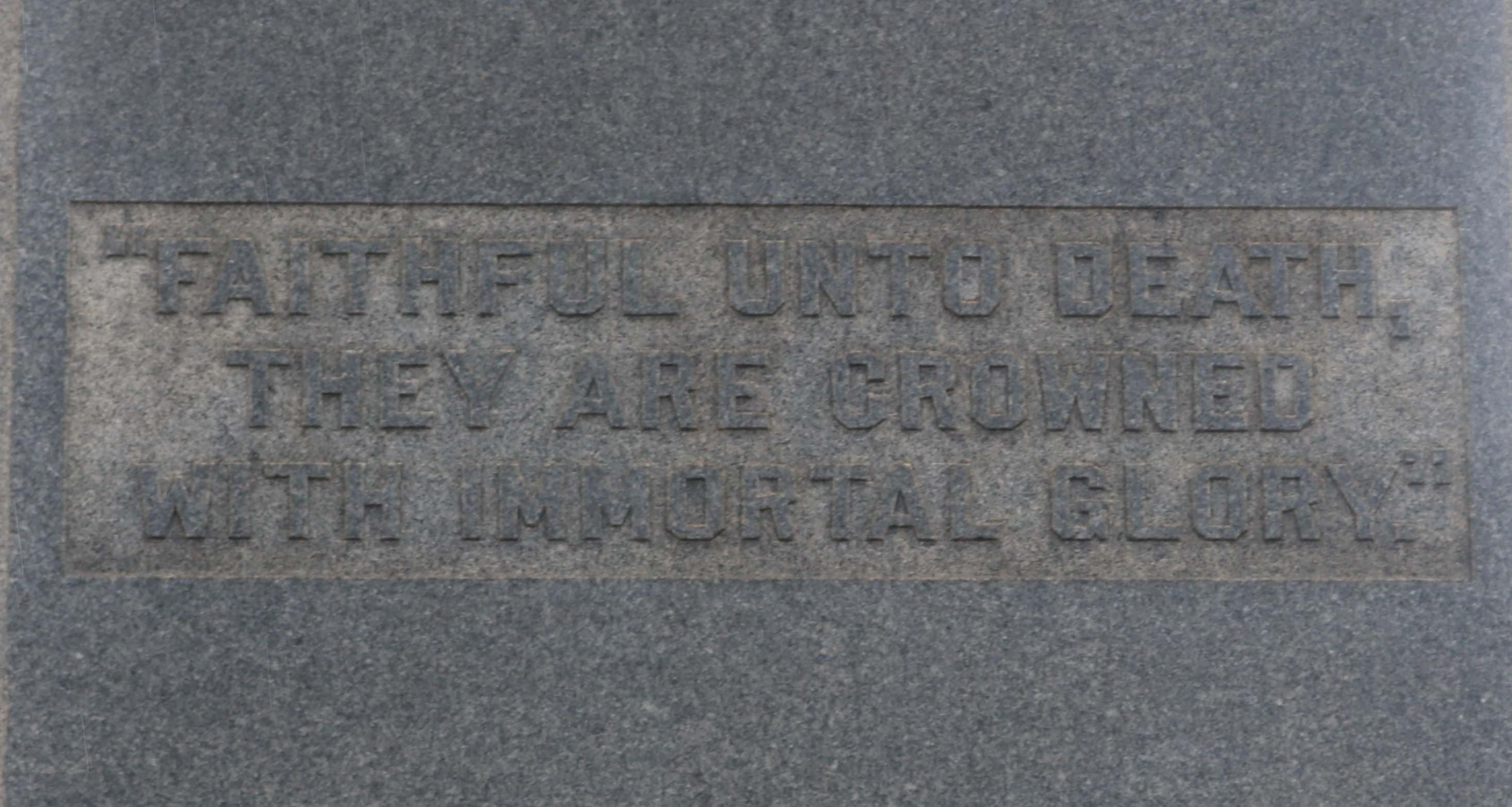

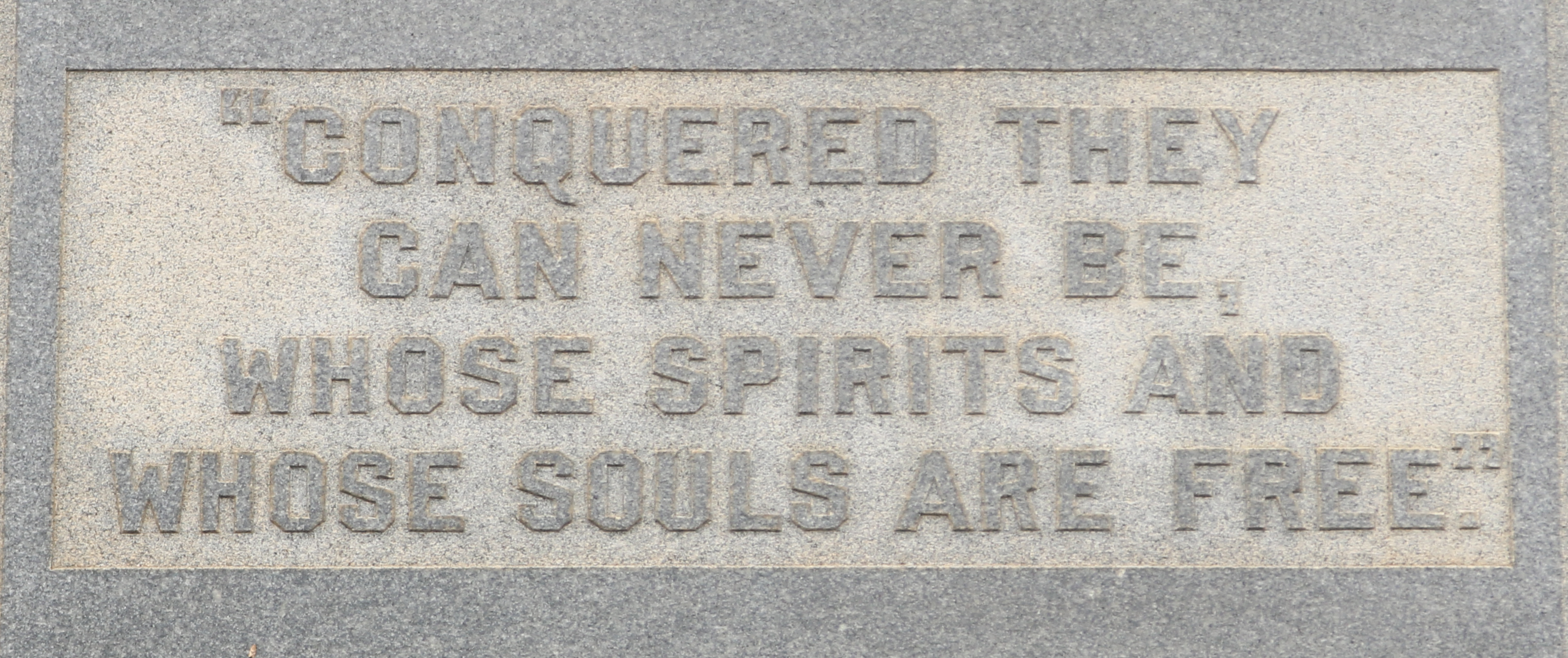

Engraving on the North side of the monument
Engraving on the North side of the monument

Engraving on the East side of the monument
Engraving on the East side of the monument

Engraving on the South side of the monument
Engraving on the South side of the monument

Engraving on the West side of the monument
Engraving on the West side of the monument
At the time, there was a community-led and government supported effort to have a memorial built to honor the fallen Confederacy soldiers from Alamance County and the dying generation of Confederate soldiers. The United Daughters of the Confederacy raised $2,100 to pay for the monument.
The United Daughters of the Confederacy was formed in September 1894. Kimberly Probolus, a fellow at the Southern Poverty Law Center and a Leading Edge Fellow for the American Council of Learned Societies, said members helped revise the narrative of the Civil War in the South to shape it through the point of view of the Lost Cause ideology. They did this mostly by erecting monuments and writing textbooks for public schools.
“History was intentionally whitewashed and taught wrong. The United Daughters of the Confederacy helped produce textbooks that lied about the Civil War,” she said. “They even have lies about the Confederacy on their website right now.”
One of the textbooks that was used in Mississippi public schools written by a member of their organization in 1914, the same year the monument in Graham was erected, said, “this book is dedicated by the author of the Youth of the Southland, hoping that a perusal of its pages will inspire them with respect and admiration for the Confederate soldiers, who were part of the Ku Klux Klan, and whose deeds of courage and valor, have never been surpassed, and rarely equaled, in the annals of history.”
The United Daughters of the Confederacy are responsible for erecting at least 450 Confederate monuments, markers, and buildings, most of which went up around the turn of the 20th century and during the Civil Rights Movement, according to the SPLC.
Although the monument was built by the United Daughters of the Confederacy and is on state-owned property, Graham's Mayor Jerry Peterman said it is technically owned by Alamance County because the county owns the deed.
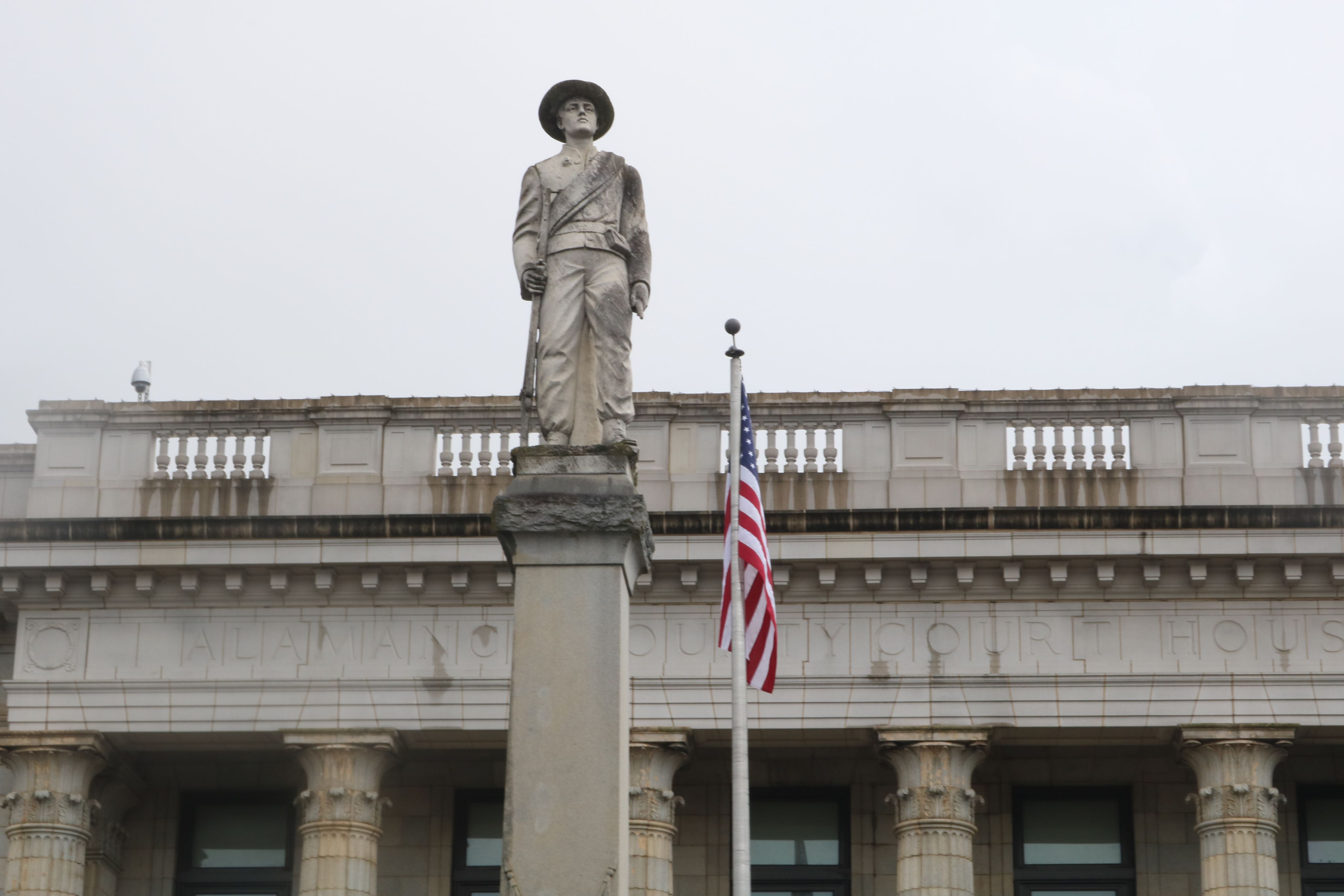
Confederate monument pictured with the American flag outside the Alamance County Courthouse in Graham
Confederate monument pictured with the American flag outside the Alamance County Courthouse in Graham
Today, the town is divided over the monument. Peterman brought together about 200 community activists and leaders from all sides to talk about the monument. “Everyone was dug in deep,” he said. “We met for three months, no one moved an inch.”
Elon History Professor Charles Irons specializes in social dynamics from the early 20th century. He said that these monuments, “converge with white supremacy conceptually, historically, and geographically.” He said they converge conceptually because the Confederacy seceded from the Union to protect the institution of slavery, historically because it was erected during a time of fervent white supremacy, and geographically because it is located outside a courthouse near where a prominent local Black leader was lynched.
Probolus said that the monument should be removed because, “Confederate monuments have no place in public space.” She said they are offensive because, “they are promoting the Confederacy, and the Confederacy not only fought to keep Black people enslaved, they also fought against the United States, they were traitors to the U.S.”
James Williams, chairman of the Board of North Carolina Commission on Racial & Ethnic Disparities in the Criminal Justice System (NCCRED), agrees with Probolus. He said symbols of the Confederacy honor something dishonorable and romanticizes something grotesque.
“If you live in a community that said it’s okay, and we support having a Confederate monument in our community, what you are also saying is people who are offended and hurt by that monument don’t matter,” he said. “Public spaces should be inviting, inclusive, they should be spaces that everybody as a part of that community would want to visit and be a part of. Confederate monuments don’t do that. They are painful.”
Williams also said these monuments were erected to, “keep Black people in their place” following eras of challenges to the racial hierarchy.
Probolus called the Confederate monument in Graham a, “symbol of hate and white supremacy,” because, “they were put up really during two times periods, the first was after Reconstruction during the Jim Crow era and the second was during the Civil Rights Movement. And they were really an attempt by heritage groups like the United Daughters of the Confederacy to venerate the values of the Confederacy and to promote what we now know as white supremacy.”
Irons points out that the monument in Graham was erected during a “low point of race relations in our nation’s history. This is the era of Plessy v. Ferguson, separate but equal, in which the Supreme Court signs off on disenfranchisement. It’s an era of the highest per capita lynches in our nation’s history. Three Black men a week murdered by white vigilante violence. So, that’s the era, the era in which militant whites in Eastern North Carolina destroyed the last bastion of Black political power in the region with the Wilmington Race Massacre of 1898.”
Irons said that white supremacy changes over time, and that erecting monuments to honor the Confederacy was just one way people promoted white supremacy at the time.
“In erecting a monument to honor the Confederacy at this time, and putting them in such public places, putting them on courthouse lawns, on schoolhouse steps, white Southerners are emphasizing the centrality of the Confederacy and of white Southern aspirations at the center of Southern history and are ignoring Black Americans and their advancements for justice.”
Probolus also argues the Confederate monument in Graham promotes the Lost Cause ideology. The Lost Cause ideology is a myth born from the desire to rationalize the Confederacy by ignoring the central role slavery played in causing the South to secede. Probolus said that, “Black people deserve a chance to share their story.” To her, removing the monument is the first step for that to happen.
Rev. Randy Orwig of the Elon Community Church and candidate for the Elon Board of Alderman said that, “The North won battles, but the South won the narrative.”
People who believe the myth of the Lost Cause often believe that the Confederacy honorably and justifiably seceded from the Union over states’ rights and economics, not slavery. But, historians say the truth is the Confederate states seceded over states’ rights to have slavery and the economics of slavery.
The North Carolina NAACP, Engage Alamance, Down Home North Carolina, and others are suing Alamance County over the monument, calling for its removal. The lawsuit calls the soldier atop the monument, “a generic, idealized, embodiment of the insurrectionists who fought in favor of secession for the South which would continue the practice of slavery and of Black individuals.”
The lawsuit argues that protecting the monument is not worth the cost to the taxpayers and is unconstitutional because it violates the 14thAmendment's right to equal justice under the law.
The lawsuit cites the Alamance County Sheriff Office’s Annual 2020 Report. The office said they spent $750,000 policing 39 protests at the monument that year alone. That doesn’t include the cost to the Graham Police Department.
“Money wise it’s not worth it,” said Graham Mayor Jerry Peterman. But, the monument is on Alamance County property, and it’s their, “sworn duty” to protect that property.
“That money they spent is because of Black Lives Matter,” said Thomas May, the organizer of the “NC Confederate Day” rally at the monument in Graham to honor the 160th anniversary of North Carolina seceding from the union on May 20, 2021. May called monument protestors, “terrorists,” and said they don’t represent how the real people of Alamance County feel.
The lawsuit also argued that the monument is a threat to public safety.
In June 2020, Alamance County manager Bryan Hagood sent an email to the Alamance County Board of Commissioners asking them to relocate the monument. “We are currently relying on our sheriff’s office to protect the confederate memorial as it is county property,” part of the email reads, “I believe it will come to a point where the deputies will have to choose to use potentially deadly force in the course of doing so,” he said.
On October 31, 2020, the “I Am Change Legacy March to the Polls” rally at the monument was broken up by police with pepper spray. Children and Elon University students were among those pepper sprayed. Eight people were arrested.
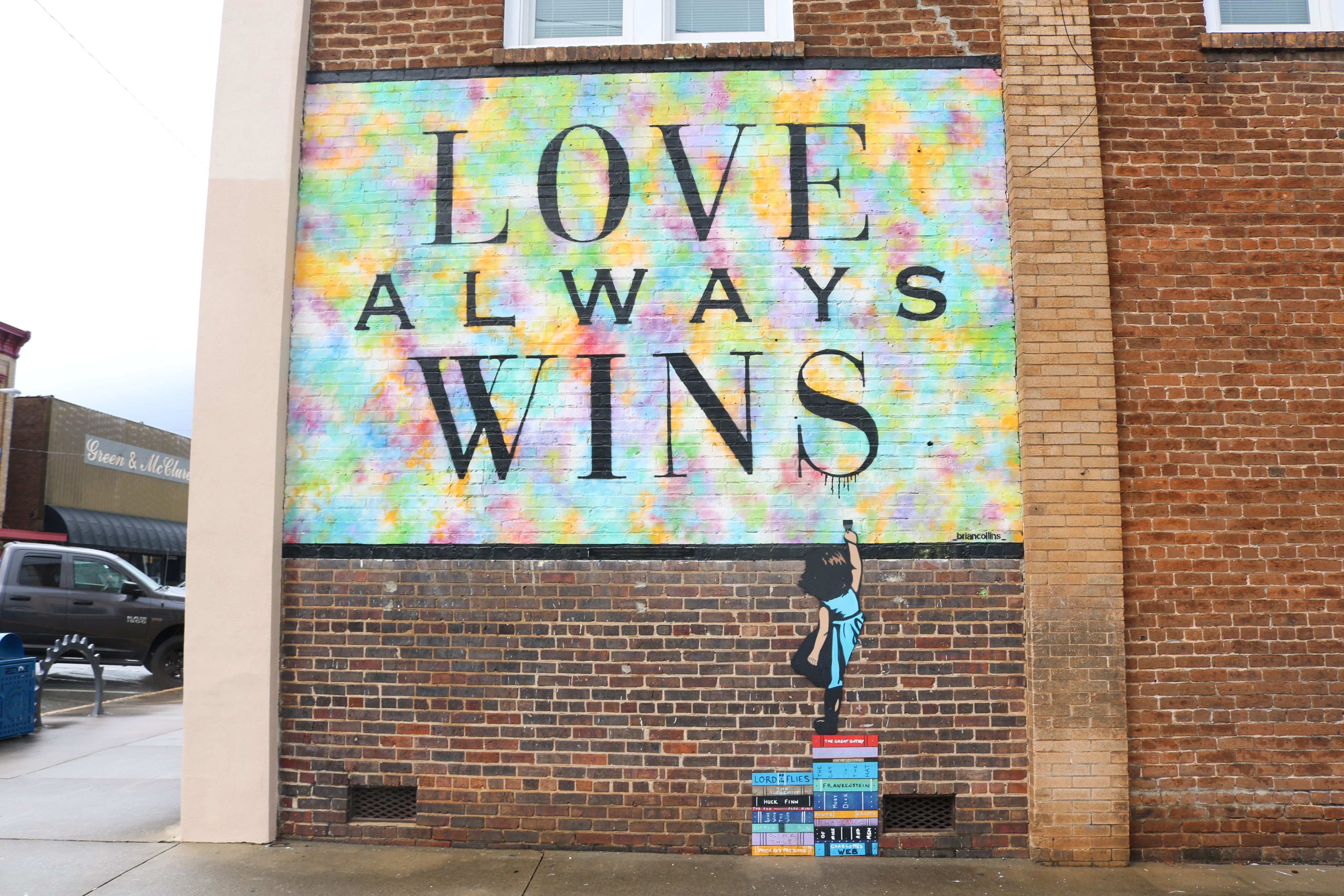
Mural that reads, “love always wins” located across the street from the Confederate monument in Graham’s Historic District
Mural that reads, “love always wins” located across the street from the Confederate monument in Graham’s Historic District
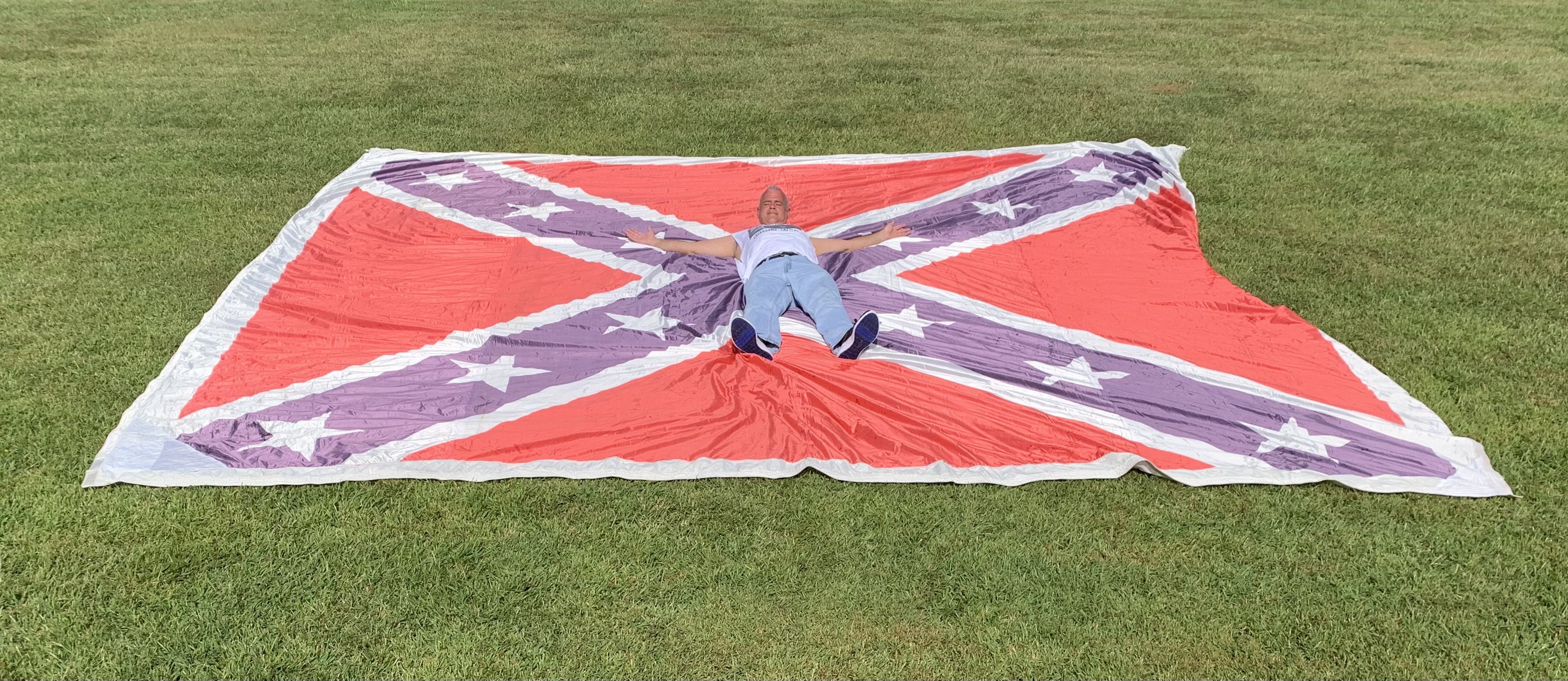
Thomas May lays in the middle of one of his Confederate battle flags
Thomas May lays in the middle of one of his Confederate battle flags
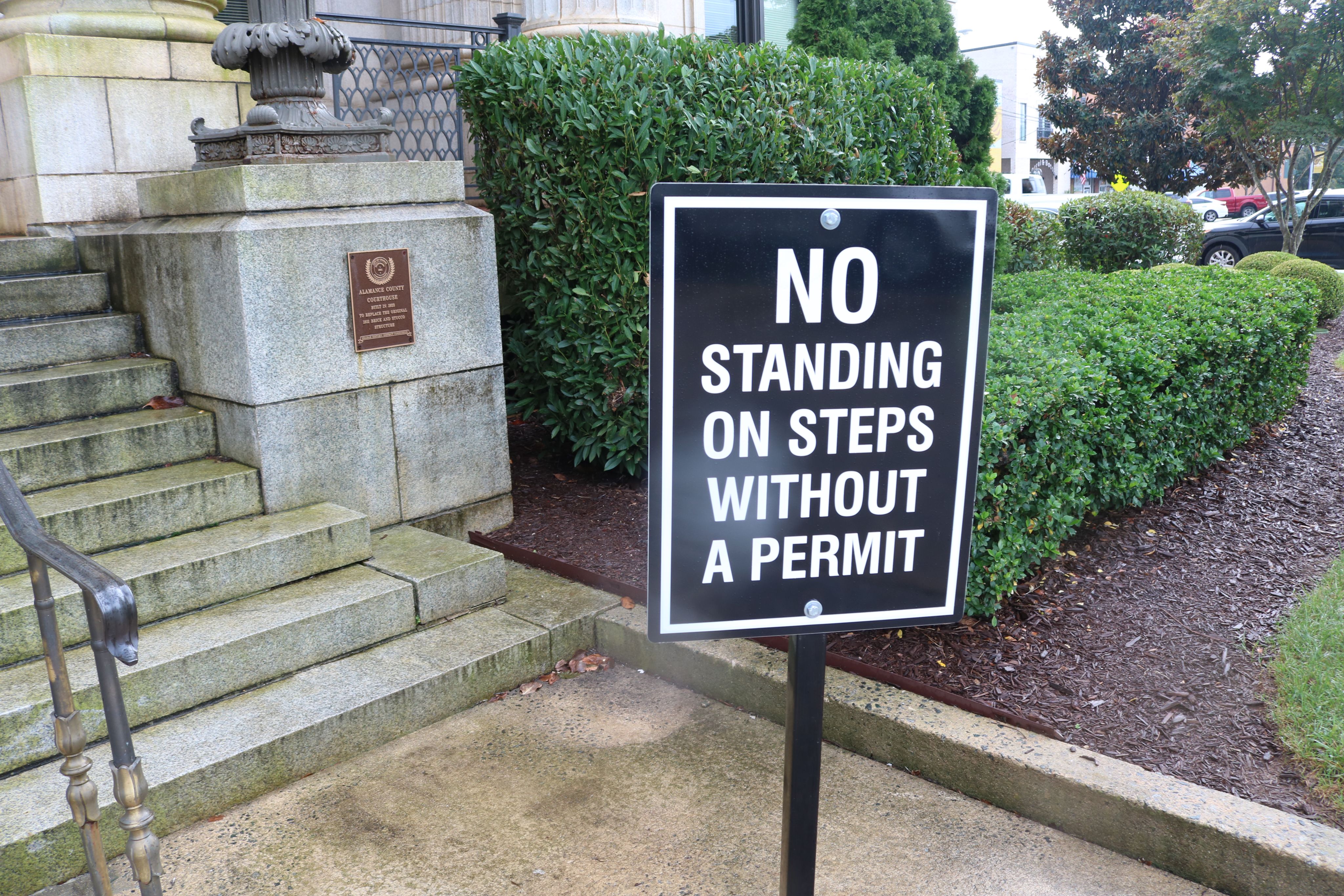
Sign posted outside the Alamance County Courthouse that reads, “no standing on steps without a permit”
Sign posted outside the Alamance County Courthouse that reads, “no standing on steps without a permit”
The NAACP lawsuit against Alamance County also claims the monument is unconstitutional because it promotes unequal protection under the law.
“Everyone has to walk by the statue to get justice,” said Orwig, who is also a plaintiff on the lawsuit.
The 14th Amendment says the government cannot deprive “any person of life, liberty, or property, without due process of law; nor deny to any person within its jurisdiction the equal protection of the laws.” Some feel that the Confederacy represents the opposite of this because they fought to keep Black people enslaved, and that honoring this outside of a Courthouse symbolizes the unequal and unfair treatment that people of color receive in the criminal justice system.
They also argue the monument should be moved because it was erected near the spot of Wyatt Outlaw’s lynching. H.K. Edgerton, an activist and former president of the Asheville, North Carolina chapter of the NAACP, said that while Outlaw’s story was important, it doesn’t have anything to do with the Confederate monument. May and Peterman agree with Edgerton, but, Probolus said, “if Wyatt Outlaw’s story is not going to inspire or move people, I’m not really sure what evidence you need."
Outlaw, a Black man born in 1820, became a community leader in Graham after the Civil War. He helped found the Loyal Republican League in Alamance, was one of the trustees deeded land to establish the African Methodist Episcopal Church in Alamance County, and he was even appointed to the town council and became Graham’s first Black public official, says Irons.
One night the Ku Klux Klan rode through the town. Outlaw and a group of men shot at the Klansmen to scare them away, injuring no one.
The night of February 28, 1870, the Klan responded by dragging Outlaw from his home and lynching him in the Graham Courthouse square. They left a message on his chest, “beware, ye guilty, both white and Black.” Although historians argue over the exact location of where this happened, they know it was within the vicinity of where the Confederate monument stands today.
“Outlaw wasn’t lynched because he was Black,” Williams said, “he was killed because he was a Black man on the move.”
Wyatt Outlaw and other high profile lynches at the time led to the Kirk-Holden War, where Republican Governor William W. Holden brought in former Union officer George W. Kirk and a few hundred volunteers at his command to put down the Ku Klux Klan.
One person they arrested for being involved in Wyatt Outlaw’s lynching was Jacob Alston Long. According to Elon University’s Committee on Elon History and Memory Report & Recommendations from Fall, 2020, J.A. Long was one of the organizers of North Carolina’s Ku Klux Klan and the younger brother of Elon University’s first president William Samuel Long.
Backlash to the Kirk-Holden War led to Gov. Holden becoming the first governor in U.S. history to be impeached and removed from office. No one was charged for Outlaw’s murder.
After helping to murder Wyatt Outlaw, Jacob A. Long was able to go back to the spot of the lynching over 40 years later when he helped dedicate the Confederate monument in Graham along with other members of the Ku Klux Klan and the United Daughters of the Confederacy.
At the dedication, according to a 1914 copy of the Alamance Gleaner, he said, “it is well for us, now and then, to turn aside from the duties of everyday life and together celebrate some great event… to recall the achievements of the great and good of our own race and blood.”
One major obstacle for those who want the monument removed is a North Carolina state law passed in 2015 that prohibits the permanent removal of an “object of remembrance located on public property.” Objects of remembrance are defined under the law as, “a monument, memorial, plaque, statue, marker, or display of a permanent character that commemoratives an event, a person, or military service that is part of North Carolina’s history.” They can only be removed to preserve the object, when necessary for construction, time limit for temporary relocation, or similar prominence for permanent relocation. There is also a public safety exception, private ownership exception, and an exception for highway markers. This law is often cited to protect Confederate monuments throughout the state.
Mayor Peterman said he must follow the law, and that means protecting the monument. “When I’m elected mayor of Graham, you put your hand on the Bible, say you’re going to support and defend all of the laws of North Carolina and the federal government and the city of Graham” he said. “So, that means that myself, the Sheriff of Alamance County, all of our city council, we have to defend those laws.”
May said that people who take down Confederate monuments in North Carolina are “breaking the law.”
Edgerton agreed. “Removing monuments is anarchy,” he said. “People have to respect the rule of law… Conform to the rule of law, not social expectations.”
Probolus disagrees. "Communities should have the final say,” she said, "the law makes that very difficult to happen.”
Mayor Peterman mentioned the 1,100 people from Alamance County fought for the Confederacy during the Civil War and are the ancestors of generations of Americans that came after them. “Are these fallen Alamance people not allowed to be memorialized?” he asked.
“It is a war memorial to the courageous men and women defending their homeland from an army that came here to rape, murder, pillage, plunder, and steal,” said Edgerton. “It represents all colors and creeds.” He later said, “we were a family. It’s a family memorial,” and those who want the monument to come down are, “trying to tear the South apart.”
“It’s heritage and it’s history,” said May. Both May and Edgerton talk about the “false narrative” that the Civil War was fought over slavery. “Winners get to write the narrative,” May said, “and they created a false narrative around the war, that the Confederacy is racist.” May said that the Confederacy seceded from the Union over states’ rights and tariffs. “They don’t teach real history anymore,” he said. “It’s a generational thing.”
Irons argued that removing a monument is not the same as erasing history. “A monument is an example of history we’re celebrating,” he said, “removing it shows we aren’t celebrating white supremacy,” and that, “we can remove white supremacy while still remembering fallen soldiers.”
Williams agrees with Irons' sentiment. “What’s erasing history is a Confederate monument that was erected in the first place based upon the lies of the Lost Cause, and the fact that somehow these are honorable people. That’s defacing and erasing history.” he said. “We want history to be told. We want the true history, the accurate history, to be told. And that’s what people are afraid of.”
Edgerton views attacks on Confederate monuments as attacks against Southern heritage. “Attacking them is un-American, and any Southerner attacking these monuments is a traitor to history,” he said. “I’ll take my stand in dixie-land with my Southern family and the Southern white man.”
“This thing about heritage, well, whose heritage?” Williams asked. This is the same question posed on the SPLC's billboard in Graham. “It certainly don’t represent my heritage,” he answers. "Don’t I count?"
Edgerton fears removing Confederate monuments would be a slippery slope. “Whatever you do in Graham will effect a monument being taken down someplace else or how someone else interprets a Confederate soldier’s monument,” he said. “What’s next, taking down Martin Luther King Jr. statues because he was socialist? Leave the monuments alone. Leave the streets alone.”
Edgerton also said that the people fighting to remove the monument should spend their time tackling more important issues. “There are baby brothers on corners with their pants down selling drugs,” he said, “women have no mobility. Let’s solve this instead of attacking symbols.”
Orwig disagrees. “Obviously this is not the real problem,” he said, “it’s a symbol of the problem.”
“Removing symbols of white supremacy is just the first step,” said Probolus. “It won’t end racism, but it should still happen.”
While there are those who want the monument removed and those who want the monument to stay outside the County Courthouse, there are also those who support relocating the monument. On June 29, 2020, 50 Alamance County community leaders signed a letter asking for the monument to be relocated. “While this artifact is undeniably part of our history,” the letter reads, “for many in our community, it represents an ideology incompatible with equality.”
The letter also said, “the monument’s prominent location before a house of justice, an entity which has historically failed to serve our communities of color with equity, perpetuates this symbol as a barrier to the inclusion we aspire to achieve.”
Among others, the letter was signed by local politicians, Elon University leaders such as President Connie Book, and faith leaders such as Rev. Randy Orwig.
“I’m not coming at this from a political point of view, I’m coming at this from a point of faith.” Orwig said. “My faith, and I think the Christian faith, teaches us to try and move towards some sense of equity.”
He said that there is a way to remember the dead without promoting white supremacy. He said that a courthouse is no place for a Confederate symbol, but that a memorial park or a cemetery would be a better location.
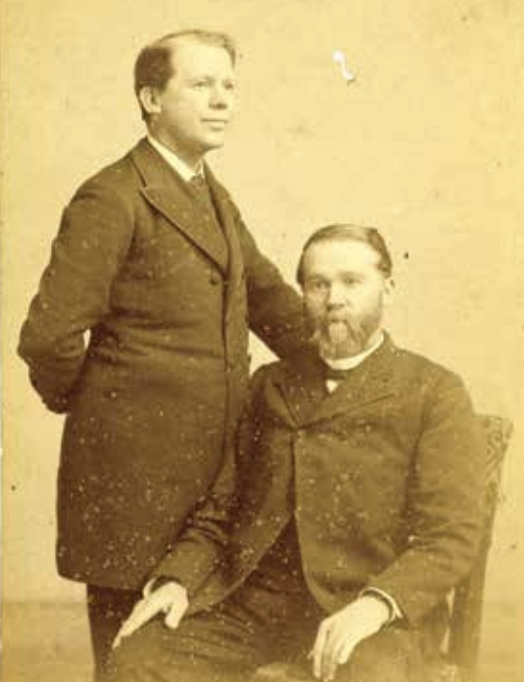
A portrait of brothers William S. Long and Jacob A. Long
A portrait of brothers William S. Long and Jacob A. Long
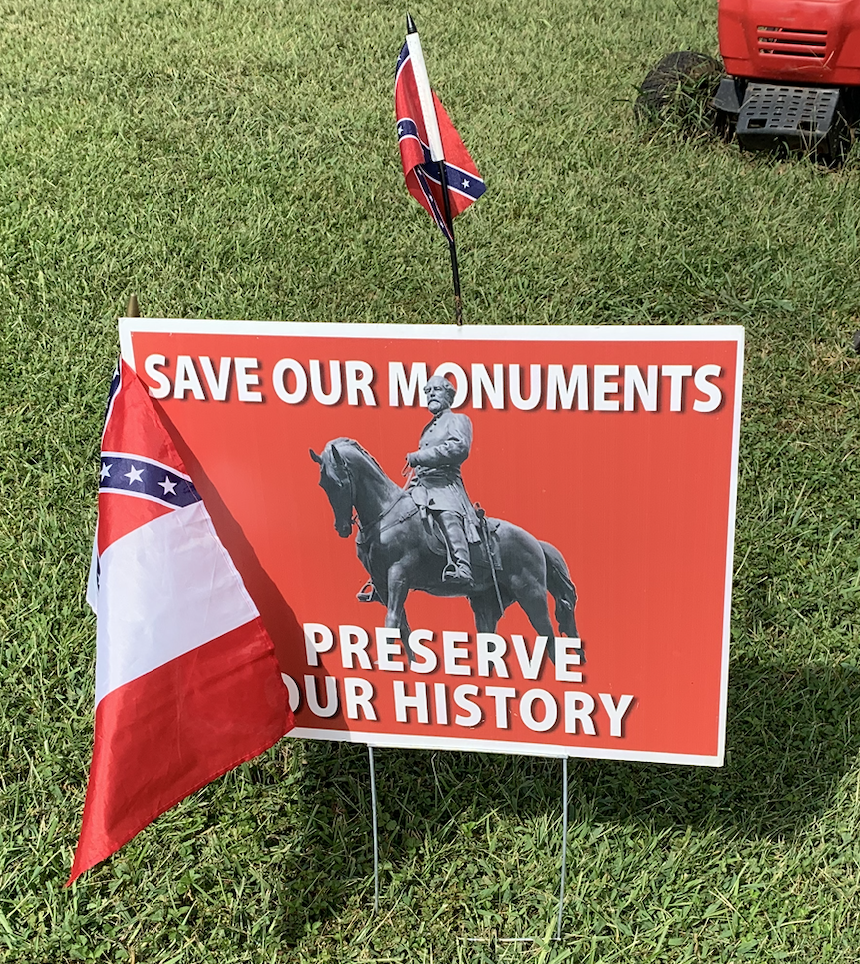
A sign posted outside of Thomas May’s house pictures the Robert E. Lee Confederate monument from Richmond, VA and reads, “save our monuments, preserve our history”
A sign posted outside of Thomas May’s house pictures the Robert E. Lee Confederate monument from Richmond, VA and reads, “save our monuments, preserve our history”
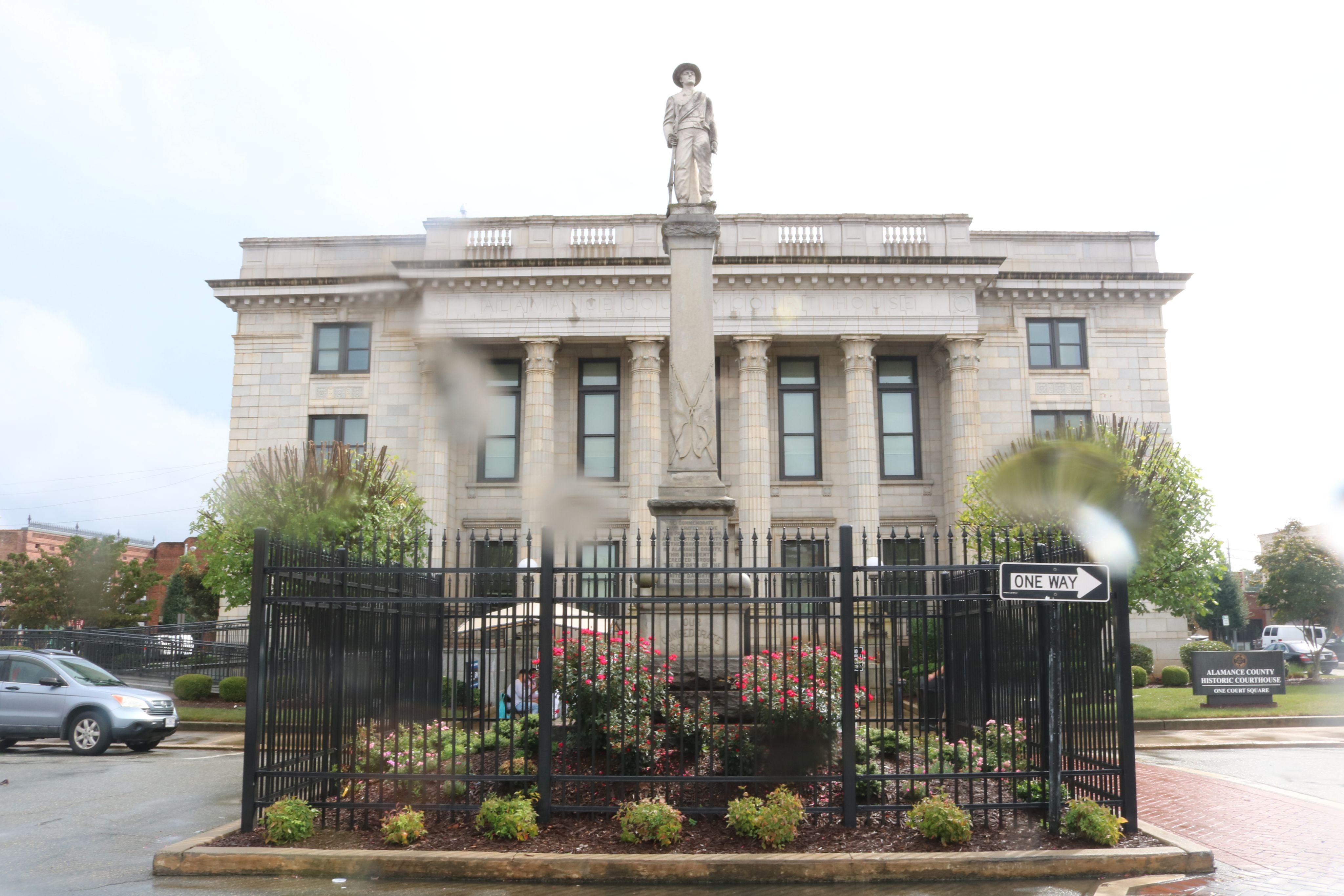
The Alamance County Courthouse Confederate monument towers over the city of Graham
The Alamance County Courthouse Confederate monument towers over the city of Graham
Picture of H.K. Edgerton speaking at a rally in front of the Confederate battle flag. Source: H.K. Edgerton
Picture of H.K. Edgerton speaking at a rally in front of the Confederate battle flag. Source: H.K. Edgerton
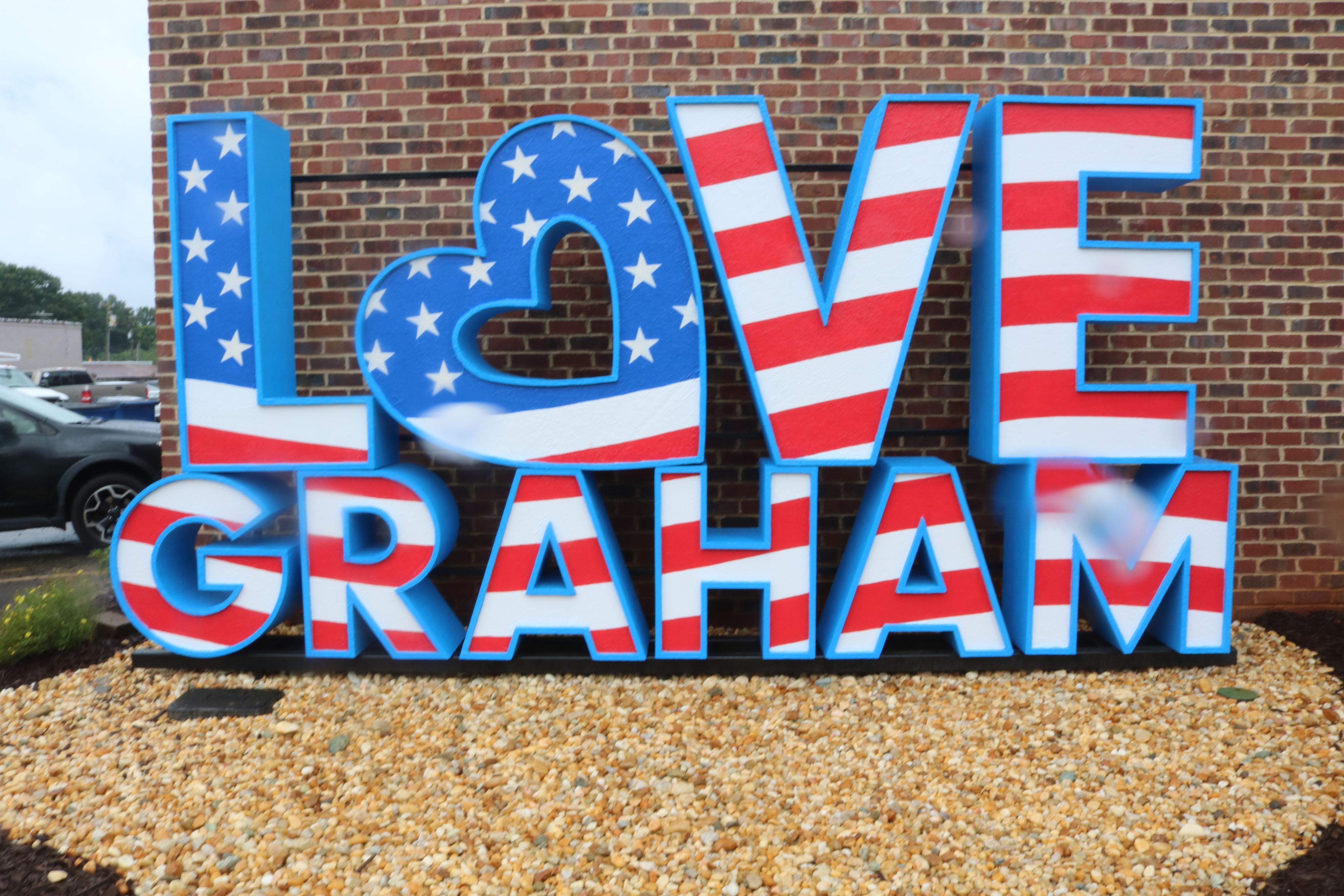
A sculpture in Graham’s Historic District reads “Love Graham”
A sculpture in Graham’s Historic District reads “Love Graham”
The debate over the Confederate monument outside the Alamance County Courthouse in Graham is far from over. The NAACP lawsuit against Alamance County will continue to be a long, drawn out process, and Orwig says appeals are expected no matter who wins.
May suggested putting the issue on the ballot to let the people of Graham and Alamance County decide for themselves. Mayor Jerry Peterman said that during the three months of debate, they discussed putting it up to vote. Half of the people in the room supported it, and the other half didn’t, because “we know that this county would probably vote, historically vote, to keep the monument as it is,” he said. “And that wasn’t acceptable to a lot of people.”
Williams hopes that future elections will bring change to the community. He points out that all five of the Alamance County Commissioners are white, even though people of color make up about 38% of the county’s population, according to the U.S. Census Bureau. “They’re not representative of the county,” he said, “They don’t give a damn about Black people.”
Probolus agrees, saying “the 2015 law is not the only factor, our elected officials continue not to do anything about it.” But, she said she is inspired by momentum they’re building. “Change is possible,” she said. “Ordinary people can change history and impact their communities.” But, “removing symbols isn’t enough,” she said, “we need inclusive communities and to stamp out white supremacy.”
“Each generation chooses our exemplary history,” Irons said. “We should choose an inclusive version of history.”
Hear more about the debate and what each interviewee had to say by clicking on their names down below:

